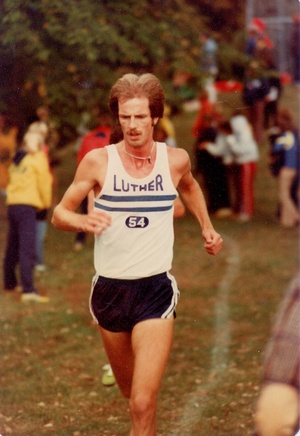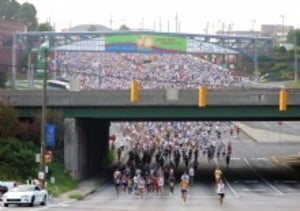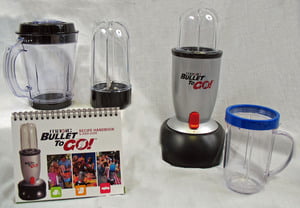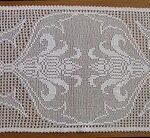As a competitive distance runner I was always searching for a “magic bullet” to make myself faster at the 5K and 10K distances. While I never ran world class times, I did discover a couple “tricks” that worked to produce times that were in the top 1% nationally with a 14:45 for 5K and a 10K best of 31:10.
Here is the little “twin” secret: To run your best middle distance times you have to think like a marathoner but train to race like a miler. Allow me to explain.
The formula for success in distance running is not that complex. You need to run long distances to develop endurance (50% of your training) run hills to develop strength (20% of your training) do intervals to develop pace (20% of your training) and do sprint training to improve your speed (10% of your training.)
You should always start your base training with about 8 weeks of easy-paced endurance running. It is okay to mix in a few pickups and sustained spurts to keep your daily runs interesting, or to find some hills for variety. But the basic goal for two months is to build your baseline stamina. Almost every distance runner knows this, but it can be hard to keep with the plan. You don’t want to mess around by starting to run fast before you really should.
TRICK ONE: LEARNING TO THINK LIKE A MARATHONER
Basically, base training is learning to think like a marathoner. Control and discipline are everything. You should vary your pace enough to avoid fatiguing the same muscles every day, and remember to alternate your shoes and training surfaces if possible to prevent overuse injuries. The primary goal is to “put in the miles” and avoid getting hurt or sick. If you feel stale some days, start really slowly and accept that you might need to cut that day’s run in half. The famed University of Oregon running coach Bill Bowerman was famous for being able to see fatigue in his runners. You need to be your own Bill Bowerman during base training. It is better to take a day off than to lose a week to a cold, or worse, to sustain an injury.
A few times in my running career I had the opportunity to train with runners who were far superior in ability. One of the things I learned from them is that base training should be extremely slow. I trained with a group of 29:00 10k runners who did all their 20 milers at 8:00 per mile pace or slower. This was a much more pedestrian pace than the long runs I did with teammates in college with whom I would do 20-mile Sunday runs at an average pace of 6:00-6:30 per mile. That was too fast to allow recovery from a race the previous day and too hard to allow the body to be rested for our typical Monday night speed session. Sometimes we’d even have meets on Tuesdays, and that would add up to three consecutive “hard” days. We were breaking down our bodies with all that hard effort. By season’s end most of us were stale or our times had plateaued. Only one year did we achieve our season goals by placing 2nd in the national cross country meet, and that was thanks to some talented freshman who backed off enough to stay fresh for the big meets.
By contrast, training with the elite athletes I met in later years was a lesson in leisurely runs of 15-20 miles, all at conversation pace. We also did one 3 hour run in 40 degree temps and occasional rain showers. But we ran slow and disciplined, thinking like marathoners. And telling lots of dirty jokes along the way.
Sometimes toward the end of these long runs (and usually toward the end of the training season and before racing season started) the group would accelerate to 5:00 pace, completing the last 5K in 15:00-15:30 range. But that was after a month or so of long runs had steeled their bodies to handle the distance. More typically, long runs started and ended like an even paced marathon. This built up endurance foundation for running the 5K and 10K distances during the racing season.
During your second 8 weeks of training it is important to mix in hill training. A typical workout might consist of 8 steady uphill repeats at 70-80%% of your best race pace. The hill should be moderate. It’s always fun to find a training hill that gradually increases in grade as you go up. That puts a real grinder on your system, but you should strive to hold steady at the 70% pace effort. For a 7:00 miler, that means running a half mile hill around 4:40-5:30 per half mile pace. A workout of 8 hill repeats delivers 28-30 minutes or so of increased effort, but be careful to train without strain. Also, be smart on the downhills to avoid repetitive stress injuries. If you have no hills where you live, put on an extra layer of sweats to weigh you down a little, and wear your heaviest training shoes and socks. Then do 3:00 minute surges with 6:00 jogs between. Running into a stiff wind can also give you the same effect as running hills. Among the cyclists with whom I now train, a 30 mph wind is called an “Illinois hill.” Runners could learn from that.
When you start to add in speed before the racing seasons, you’ll need to add intervals on the track. I always liked ladder repeats of 200, 400, 600, 800 and mile intervals. You work your way up the ladder and then back down. That way your mind has firm goals and you keep from getting bored. It is also easy to add distance to the workout by adding repeats at each distance. I knew I was very fit when I could manage a “double ladder” doing two intervals at each interval step at near race pace.
Ladders also teacher your body to apply goal pace at varying distances. I always choose to keep jogging between intervals during a ladder, careful to maintain my running form even when exhausted. That’s part of the discipline of doing intervals. You’re training your mind as well as your body to handle the tempo, base and effort. Sometimes it gets quite difficult and there are days when you won’t hit your times. That’s training. Accept it and look at the big picture as you will eventually improve… have good days as well.
It helps to have a partner to do ladders. One: to keep track of the distances. Two: To keep you from cheating when you get tired. If you or your partner start dropping off precipitously during an interval workout it is probably best to cut the workout short rather than thrash your body. Wait two days and see how you recover. If you feel a cold coming on, your training load overall has been too heavy. (And, I might suggest: Take zinc to beat the cold).
The “day after the day” lag rule is important to remember. The next day after a hard workout must always a rest day, but often so is the second.
TRICK TWO: TRAINING TO BE A MILER
During racing season, I always liked to find an All-Comers track meet to test my interval and speed training before heading to the roads. In the Chicago suburbs, the best All-Comers meets were always held at North Central College in Naperville. Runners of all abilities were welcome, but many times world class runners like Jim Spivey, Ken Popejoy or others would show up. Those nights were magic because everyone knew the pace would be quicker and you could get pulled along to your own best time.
In any case, jumping into a fast mile or 5000 meter race on the track teaches your legs to “roll over” faster. That sensation of going faster than you do in training teaches your mind to accept the tempo necessary to race better on the roads.
I ran my best 5000 meters on the track in a race that started at midnight during an All Comers meet at North Central College. While the hour at which the race commenced seemed a little crazy, weather conditions were near perfect: 60 degrees and no wind. I ran 14:47 and took 14th among 35 other runners in a race that was won in 14:05 by a national champion Division III runner from nearby Wheaton College. When you are reasonably fit, it is easy to get pulled to a faster race pace by better runners.
If you’re not confident to try something like racing on the track, try moving up a group at your weekly group training session to get pulled around by a faster pace. Or, invite some faster runners to your weekly solo speed workout to pace you through a mile at faster than your 5K or 10K race pace. When I was at peak fitness, I was hired out to lead a corporate executive through noontime workouts at a track in downtown Chicago. With my help, he improved his 5K time by 35 seconds that summer and won his age group in several summer circuit races. Training with pace guidance can “enlighten” your body and mind to the fact that you really can go faster.
Tricking your body into going faster through fast-paced running is the “miler” method to becoming a better distance runner. Since miles are still the measuring stick for many races, knowing you can run a mile in 6:00 when your goal pace is 7:30 for a 10K race gives you much confidence by making your “normal” race pace seem “slow” by comparison.
This works particularly well if you actually go out and run an all-out mile at a track. The effects can actually be profound if your mile race effort is quite close to your intended 5K or 10K race.
I used the miler trick several times before middle distance road races at 5K and 10K with considerable success. During a Thursday night Open meet I won a competitive mile in 4:22. That Saturday morning I ran 50:20 and took second place in a hilly 15K, beating a whole group of teammates that normally left me in the dust. The miler trick can even hold true by running a 5K prior to tackling 10k distance. I once ran a competitive 5K on the track one Saturday (15:20) and came back on Sunday to run a 10K race in under 32:00. You can’t do that every weekend, and recovery following such an effort needs to be handled with caution, but the results were fun.
My legs felt fresh and alive each time because the sensation of running at a much higher rate of speed before a road race made 5:00 pace feel easy. It works for runners with any range of PRs at 10k, from 29:00 up to more than an hour!
Of course you have to have done the base and endurance work, intervals and speed training to build up to race fitness before using the miler’s trick. But once you’ve raced a couple times during the season and want to build your confidence by running below race pace, it is worth “racing” a mile on the track. I don’t necessarily recommend racing the night before, but doing a fast mile 4-5 days out from your goal race is an excellent honing strategy that can put you in a mood to race your hardest.
If you are a miler or half-miler looking to get faster, you must of course adjust your interval paces accordingly. Prior to running a four-mile relay at Drake Relays where we knew we’d be outclassed by runners from much larger schools, our small college four mile relay team practiced running 4:00 mile pace at quarter and half mile intervals. The team managed times of 4:08, 4:12, 4:16 and 4:19. Not bad for small college Iowa! Of course Arkansas won with the race with an average per-mile pace of 4:04. I told you we were out of our league…
But the lesson was learned. You can go faster if you teach your brain to think like a miler.
Truly, confidence is one of the most important assets a runner has to improve his or her times. Endurance training (thinking like a marathoner) builds confidence to go the distance. Interval training builds confidence to sustain the pace. Sprint training (thinking like a miler) gives you confidence to break through mental set points about pace and time.
That’s how you break through to better times at 5K and 10k. Be smart and then be bold. And don’t forget to double-knot your shoelaces.





